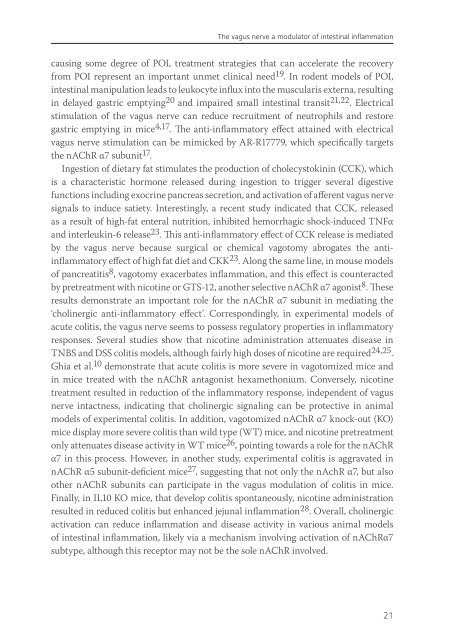The vagus nerve as a modulator of intestinal inflammation - TI Pharma
The vagus nerve as a modulator of intestinal inflammation - TI Pharma
The vagus nerve as a modulator of intestinal inflammation - TI Pharma
You also want an ePaper? Increase the reach of your titles
YUMPU automatically turns print PDFs into web optimized ePapers that Google loves.
<strong>The</strong> <strong>vagus</strong> <strong>nerve</strong> a <strong>modulator</strong> <strong>of</strong> <strong>intestinal</strong> <strong>inflammation</strong><br />
causing some degree <strong>of</strong> POI, treatment strategies that can accelerate the recovery<br />
from POI represent an important unmet clinical need 19 . In rodent models <strong>of</strong> POI,<br />
<strong>intestinal</strong> manipulation leads to leukocyte influx into the muscularis externa, resulting<br />
in delayed g<strong>as</strong>tric emptying 20 and impaired small <strong>intestinal</strong> transit 21,22 . Electrical<br />
stimulation <strong>of</strong> the <strong>vagus</strong> <strong>nerve</strong> can reduce recruitment <strong>of</strong> neutrophils and restore<br />
g<strong>as</strong>tric emptying in mice 4,17 . <strong>The</strong> anti-inflammatory effect attained with electrical<br />
<strong>vagus</strong> <strong>nerve</strong> stimulation can be mimicked by AR-R17779, which specifically targets<br />
the nAChR α7 subunit 17 .<br />
Ingestion <strong>of</strong> dietary fat stimulates the production <strong>of</strong> cholecystokinin (CCK), which<br />
is a characteristic hormone rele<strong>as</strong>ed during ingestion to trigger several digestive<br />
functions including exocrine pancre<strong>as</strong> secretion, and activation <strong>of</strong> afferent <strong>vagus</strong> <strong>nerve</strong><br />
signals to induce satiety. Interestingly, a recent study indicated that CCK, rele<strong>as</strong>ed<br />
<strong>as</strong> a result <strong>of</strong> high-fat enteral nutrition, inhibited hemorrhagic shock-induced TNFα<br />
and interleukin-6 rele<strong>as</strong>e 23 . This anti-inflammatory effect <strong>of</strong> CCK rele<strong>as</strong>e is mediated<br />
by the <strong>vagus</strong> <strong>nerve</strong> because surgical or chemical vagotomy abrogates the antiinflammatory<br />
effect <strong>of</strong> high fat diet and CKK 23 . Along the same line, in mouse models<br />
<strong>of</strong> pancreatitis 8 , vagotomy exacerbates <strong>inflammation</strong>, and this effect is counteracted<br />
by pretreatment with nicotine or GTS-12, another selective nAChR α7 agonist 8 . <strong>The</strong>se<br />
results demonstrate an important role for the nAChR α7 subunit in mediating the<br />
‘cholinergic anti-inflammatory effect’. Correspondingly, in experimental models <strong>of</strong><br />
acute colitis, the <strong>vagus</strong> <strong>nerve</strong> seems to possess regulatory properties in inflammatory<br />
responses. Several studies show that nicotine administration attenuates dise<strong>as</strong>e in<br />
TNBS and DSS colitis models, although fairly high doses <strong>of</strong> nicotine are required 24,25 .<br />
Ghia et al. 10 demonstrate that acute colitis is more severe in vagotomized mice and<br />
in mice treated with the nAChR antagonist hexamethonium. Conversely, nicotine<br />
treatment resulted in reduction <strong>of</strong> the inflammatory response, independent <strong>of</strong> <strong>vagus</strong><br />
<strong>nerve</strong> intactness, indicating that cholinergic signaling can be protective in animal<br />
models <strong>of</strong> experimental colitis. In addition, vagotomized nAChR α7 knock-out (KO)<br />
mice display more severe colitis than wild type (WT) mice, and nicotine pretreatment<br />
only attenuates dise<strong>as</strong>e activity in WT mice 26 , pointing towards a role for the nAChR<br />
α7 in this process. However, in another study, experimental colitis is aggravated in<br />
nAChR α5 subunit-deficient mice 27 , suggesting that not only the nAchR α7, but also<br />
other nAChR subunits can participate in the <strong>vagus</strong> modulation <strong>of</strong> colitis in mice.<br />
Finally, in IL10 KO mice, that develop colitis spontaneously, nicotine administration<br />
resulted in reduced colitis but enhanced jejunal <strong>inflammation</strong> 28 . Overall, cholinergic<br />
activation can reduce <strong>inflammation</strong> and dise<strong>as</strong>e activity in various animal models<br />
<strong>of</strong> <strong>intestinal</strong> <strong>inflammation</strong>, likely via a mechanism involving activation <strong>of</strong> nAChRα7<br />
subtype, although this receptor may not be the sole nAChR involved.<br />
21













